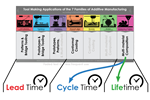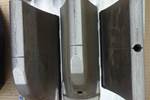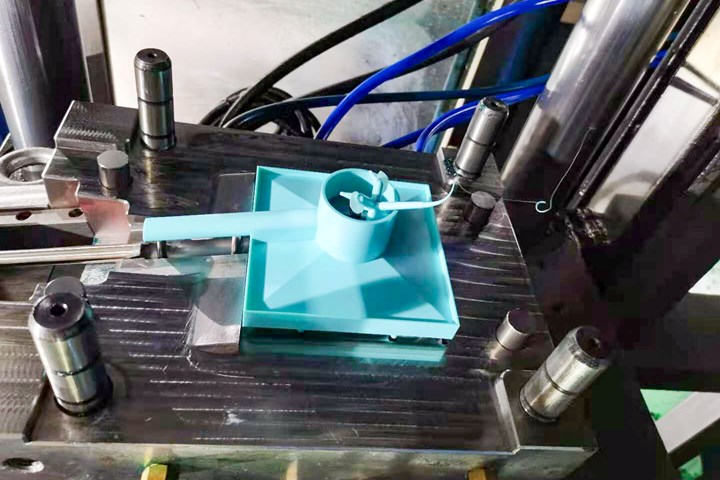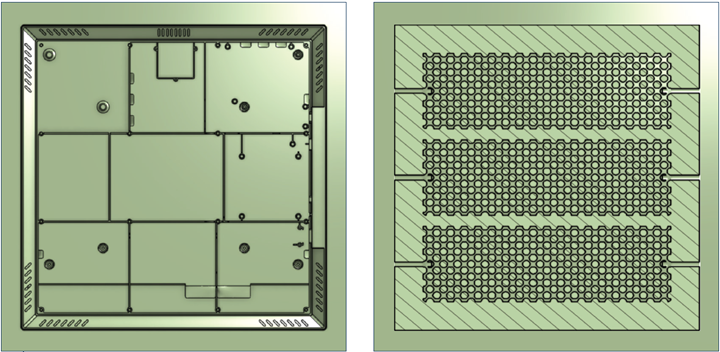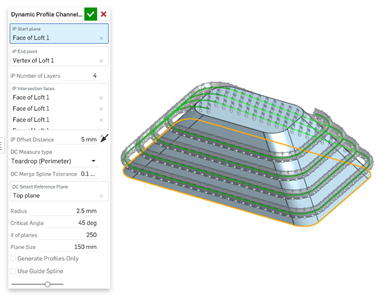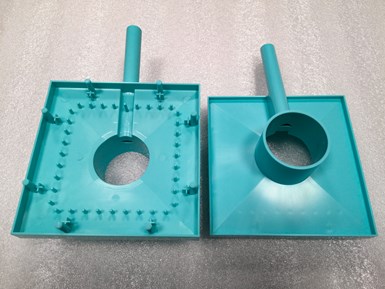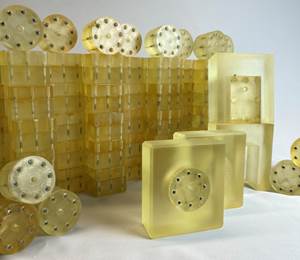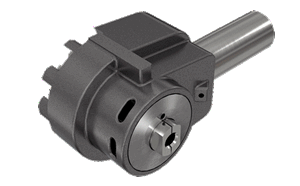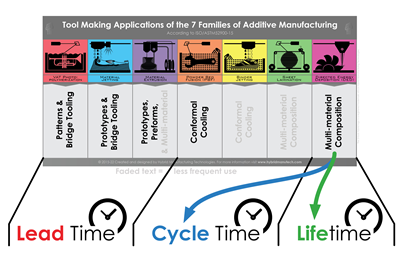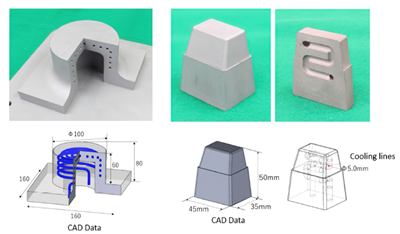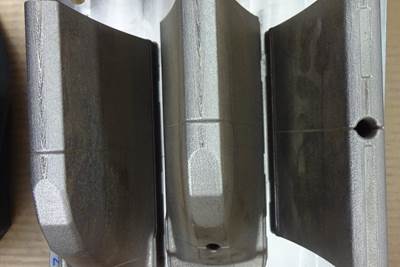Plug-and-Play 3D-printed mold insert installed in an injection mold. Photo Credit, all images: Instaversal
When it comes to 3D printing conformal cooling channels, there have been two main conventional powder metal material options: maraging steel (good crack resistance but poor thermal properties) and H-13/H-11 (good thermal properties but prone to cracking). However, today, another option offers the ease of build from maraging steel and the thermal properties of H-13 — a modified, high thermal conductivity (HTC) powder that offers crack resistance, excellent thermal conductivity properties and good mechanical properties.
Chemistry is Key
The last thing you want is to be uncertain about how a metal powder will act. So, the goal of developing this modified HTC metal powder was to mirror H-13 as much as possible, considering it is the material mold builders are most familiar with — offering repeatability, good structure in the as-build phase and tempering for the desired hardness.
Here are a few factors to consider when evaluating metal powders for conformally cooled molds:
- Thermal conductivity. The alloying elements in the steel determine a material’s thermal conductivity, which is all about moving heat from areas of high temperature to areas of low temperature. Alloying elements act either as a conductor or an insulator. Because of this, the silicone content was lowered to improve the thermal conductivity of this modified HTC powder. Then, to eliminate cracking or form building, it was given a hardness of 48 Rockwell with less carbon content (0.23%).
- Flow rate. This powder’s development also involved improving its flow rate properties because if a powder does not flow properly, voids and density problems occur. The HTC powder’s relative density using the metal 3D printing system was 99.96% dense, which is very close to wrought steel, resulting in a powder that flows well and prints very quickly.
- Heat treatment. Shot blast, shot peen or sandblast after the build phase to lower the peaks and valleys. Then temper and remove the part.
- Toughness. Impact toughness is related to the carbon copy content in the material and the steel matrix. The HTC powder shows up to 100 joules per square centimeter.
Other mechanical properties — tensile strength, 2% proof stress, reduction of area elongation — are all similar or better than a forged H-13 material.
Software Strategies
Going from powder to printed parts involves sourcing the material, designing the part for postprocessing and then integrating the conformal-cooled insert into the mold. However, one of the most significant limitations with printing cooling channels and features that don’t require critical overhangs and support materials is that inclination angles can result in cracking or failures in features. The key is printing features that provide the thermal benefits of the material as it relates to cooling the part, which is the leading reason mold builders use additive manufacturing (AM). So, powder choice is vital.
Using a dynamic profile channeling toolset can help mold builders implement 3D printing with a modified HTC metal powder in two ways:
- Designing cooling channels. Adjust the profile of the cooling channel normal to the X and Y plane to ensure printability based on the printer, material and design.
- Building cooling channels off of the 3D part. Current toolsets do auto channeling or autorouting, but until now, none have considered feasibility as it relates to printing. You can now leverage an HTC material to get better cooling implemented directly into your design and then have it print without error.
Dynamic profile channeling can help with embedded heat sinks and cooling channels. For example, with flat or slightly curved parts where traditional or AM methods fall short when a shop needs to put cooling channels on a large surface area. Dynamic profile channeling enables shops to create cooling channels that follow the entire surface of the part’s profile by offsetting against the specific surface, which can then integrate directly into the mold insert.
The last thing you want is to be uncertain about how a metal powder will act.
Leveraging software techniques like dynamic profile channeling can help users directly print inserts with 100% accuracy the first time with no risk of failed prints. In addition, it helps to establish an iterative design process that allows users to optimize the cooling channels and then print and use the inserts for molding parts.
A shop can also use advanced predictive engineering modeling to identify the design that will yield the best results related to cycle time. For example, testing with a modified HTC metal powder revealed a reduction in cooling time from 35 to 10 seconds.
This involves using simulations to ensure targets are hit with regards to even cooling and cooling times that meet target cycle times by identifying the material of the polymer, 3D-printed mold insert and other tooling elements, flow rate and cooling line paths. In addition, simulating before printing will avoid wasted time and resources on scrapped tooling that might not yield the desired results.
Related Content
In "Hybrid" FIM Process, 3D Printing Complements Injection Molding
Alpine Advanced Materials used a desktop 3D printer and the freeform injection molding process to reduce prototype tooling production time and cost for its customers.
Read MoreBuilding Molds: Most Popular Reads of 2024
Dive into the most-viewed content for building your mold, including topics such as cutting tools, EDM, hot runners, additive manufacturing, mold materials, machining and mold components.
Read More3D Printing Enables Better Coolant Delivery in Milling Operations
Just like 3D printing enabled conformal cooling channels in molds, additive manufacturing is now being used to optimize coolant delivery in cutting tools.
Read MoreMMT Chats: The Connection Between Additive Manufacturing Education and ROI
This MMT Chat continues the conversation with Action Mold and Machining, as two members of the Additive Manufacturing team dig a little deeper into AM education, AM’s return on investment and the facility and equipment requirements to implement AM properly.
Read MoreRead Next
The Mold Builder’s Guide to Additive Manufacturing
An overview of mold building needs that AM can address and specific AM techniques best suited to each.
Read MoreExploring AM Powders for Tooling
More options in AM tooling materials exist today that provide properties for crack resistance, thermal conductivity and heat treatment.
Read MoreHybrid Approach to Producing Mold Inserts Boosts Productivity and Profitability
Mold inserts with additively produced cooling circuits eliminate design constraints, reduce the cost of complexity, improve part dimensions, decrease cycle time and speed time to market.
Read More

